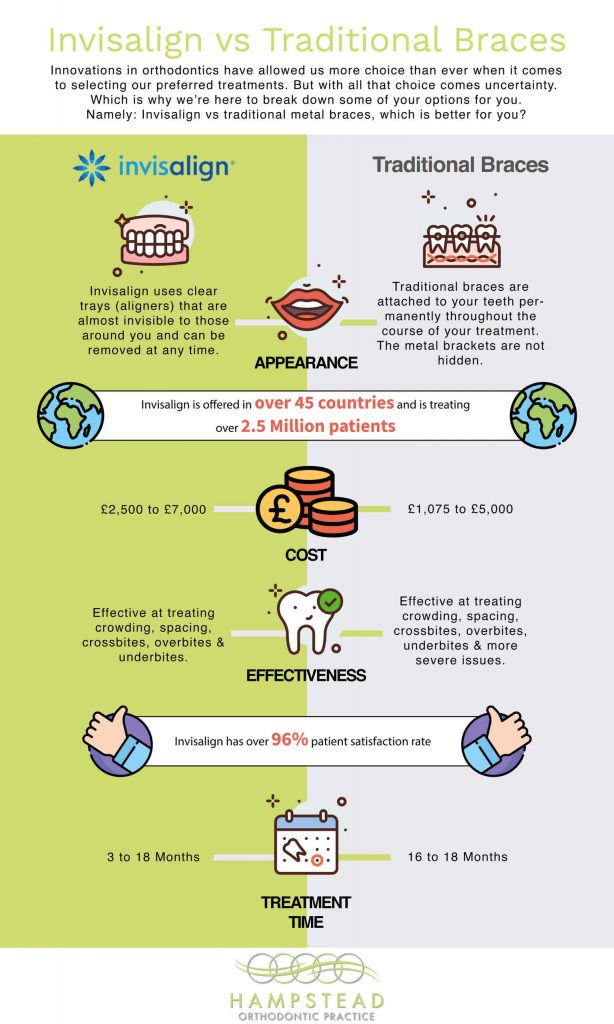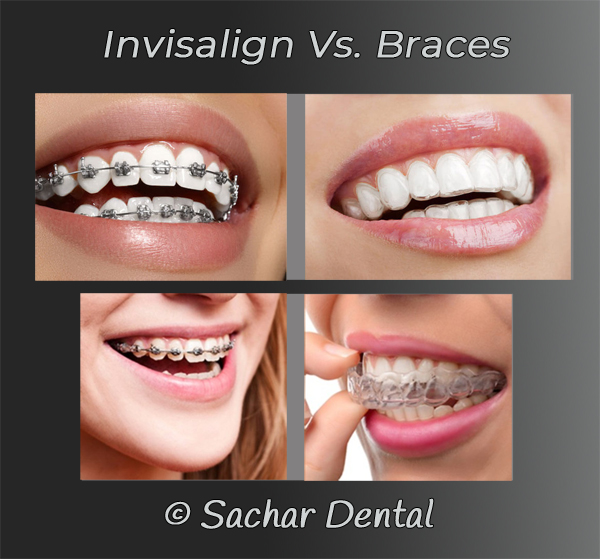Invisalign Vs. Traditional Braces: Which Is Best for You?
Are you tired of feeling like a metal-mouthed robot with traditional braces? Well, fear not, because there is a modern solution that may just be the answer to your orthodontic woes.
Invisalign, the revolutionary clear aligner system, has taken the world by storm, promising a more discreet and comfortable teeth-straightening experience.
But before you make up your mind, let’s delve into the pros and cons of Invisalign versus traditional braces, so you can make an informed decision that’s best for you.
The Basics of Invisalign
Invisalign offers a discreet and convenient alternative to traditional braces. With Invisalign, you can straighten your teeth without the need for metal wires and brackets. Instead, you’ll wear a series of clear, removable aligners that gradually move your teeth into the desired position. These aligners are custom-made to fit your teeth, ensuring a comfortable and secure fit.
One of the main advantages of Invisalign is its discreet appearance. The aligners are virtually invisible, making it difficult for others to notice that you’re undergoing orthodontic treatment. This is especially beneficial for adults and teenagers who may feel self-conscious about wearing traditional braces.
In addition to being discreet, Invisalign also offers convenience. Unlike traditional braces, the aligners can be easily removed when eating, brushing, and flossing. This allows you to maintain good oral hygiene and enjoy your favorite foods without any restrictions. However, it’s important to wear the aligners for at least 20-22 hours a day to ensure effective treatment.
Furthermore, Invisalign aligners are made from a smooth and comfortable material, reducing the likelihood of irritation and discomfort. There are no wires or brackets to adjust, and you’ll only need to visit your dentist or orthodontist every six to eight weeks for check-ups and to receive new sets of aligners.
The Basics of Traditional Braces
Traditional braces are a common orthodontic treatment option that uses metal wires and brackets to straighten teeth. They’ve been used for decades and are still widely used today.
The process of getting traditional braces involves several steps. First, your orthodontist will perform a thorough examination of your teeth and jaw to determine if braces are necessary. If they are, your orthodontist will take impressions or digital scans of your teeth to create a custom treatment plan.
During the placement of the braces, your orthodontist will carefully attach the brackets to your teeth using a special adhesive. Then, they’ll thread the metal wires through the brackets and secure them with rubber bands or other types of ligatures. Over time, these wires will apply gentle pressure to your teeth, gradually moving them into the desired position.
Throughout the treatment, you’ll need to visit your orthodontist regularly for adjustments and check-ups. The average treatment time for traditional braces is around two to three years, although this can vary depending on the individual case.
After your braces are removed, you may need to wear a retainer to maintain the results. Traditional braces are effective in correcting a wide range of dental issues, including overcrowding, spacing problems, and misaligned bites.
Treatment Duration and Progression
Once you have had your traditional braces placed and your treatment plan established, you’ll start to see the progression of your treatment duration. The length of time it takes to complete your orthodontic treatment with traditional braces can vary depending on the severity of your dental issues. On average, the treatment duration for traditional braces ranges from 18 to 36 months. During this time, you’ll have regular appointments with your orthodontist to monitor the progress of your treatment and make any necessary adjustments.
The progression of your treatment duration will be evident as you see your teeth gradually moving into their desired positions. Initially, you may experience some discomfort and soreness as your teeth start to shift. This is normal and can be managed with over-the-counter pain relievers. As time goes on, you’ll begin to notice visible changes in the alignment of your teeth, providing you with motivation and encouragement to continue with your treatment.
It is important to follow your orthodontist’s instructions and take good care of your braces during the entire treatment duration. This includes practicing good oral hygiene by brushing and flossing regularly, avoiding hard and sticky foods, and wearing any necessary rubber bands or appliances as directed. By doing so, you can help ensure that your treatment progresses smoothly and efficiently, ultimately giving you the best results possible.
Aesthetics and Visibility
When it comes to aesthetics and visibility, Invisalign offers a clear and discreet option for straightening your teeth.
Unlike traditional braces with metal wires, Invisalign aligners are transparent and virtually invisible when worn.
This means you can confidently go about your day without drawing attention to your orthodontic treatment.
Clear and Discreet
Choosing Invisalign for your orthodontic treatment allows you to achieve a clear and discreet smile transformation. Unlike traditional braces, Invisalign aligners are virtually invisible and blend seamlessly with your natural teeth.
Here’s why Invisalign is the clear choice:
– Clear aligners: Invisalign uses a series of transparent aligners that are custom-made to fit your teeth perfectly. These aligners are made from a smooth, BPA-free plastic material, making them nearly invisible when worn.
– Removable design: Invisalign aligners can be easily removed for eating, drinking, and brushing your teeth. This means you can enjoy your favorite foods without any restrictions and maintain optimal oral hygiene throughout your treatment.
With Invisalign, you can confidently go about your daily activities without feeling self-conscious about your braces. Say goodbye to metal brackets and wires and hello to a clear and discreet smile transformation.
Metal Wires Vs. Transparency
With Invisalign, you can say goodbye to the visibility and discomfort of metal wires and embrace the transparency and aesthetics of clear aligners.
Traditional braces, with their noticeable metal wires and brackets, can make you feel self-conscious about your smile. These metal components can be uncomfortable and may cause irritation to your gums and cheeks.
Invisalign aligners, on the other hand, are made of a clear, smooth plastic material that’s virtually invisible when worn. This means that you can go about your daily activities without drawing attention to your orthodontic treatment.
The transparency of Invisalign aligners allows you to feel more confident and comfortable throughout the teeth-straightening process. Additionally, the clear aligners can be easily removed for eating, brushing, and flossing, providing you with greater convenience and oral hygiene.
Comfort and Convenience
When it comes to comfort and convenience, there are several factors to consider.
First, the pain levels between Invisalign and traditional braces differ significantly.
Second, eating restrictions may vary depending on the type of treatment you choose.
Lastly, managing oral hygiene may be easier with Invisalign compared to traditional braces.
Pain Levels Comparison
One major factor to consider when comparing Invisalign and traditional braces is the level of discomfort and inconvenience experienced. Both options come with their own set of pain levels, and it’s important to understand what you might be getting yourself into before making a decision.
Here’s a comparison of the pain levels associated with each:
– Invisalign:
– Mild discomfort during the initial adjustment period as you get used to wearing the aligners.
– Some pressure and soreness when switching to a new set of aligners, which usually lasts for a day or two.
– Traditional braces:
– Discomfort and soreness after each adjustment appointment, which can last for a few days.
– Potential for mouth sores or irritation caused by the brackets and wires.
Eating Restrictions Comparison
In comparing the comfort and convenience of eating restrictions, it’s important to consider the differences between Invisalign and traditional braces.
With traditional braces, there are several food restrictions that can be quite cumbersome. Sticky and hard foods, such as caramel and popcorn, can get stuck in the braces and cause damage, leading to discomfort and additional trips to the orthodontist.
On the other hand, Invisalign offers more flexibility when it comes to eating. Since the aligners are removable, you can take them out before meals, allowing you to enjoy all types of food without any restrictions. This means you can still indulge in your favorite crunchy snacks or chewy treats without any worries.
Invisalign provides a more comfortable and convenient eating experience compared to traditional braces.
Oral Hygiene Management
Considering the convenience and comfort of oral hygiene management, there’s a noticeable difference between Invisalign and traditional braces. When it comes to maintaining good oral hygiene, Invisalign offers some advantages over traditional braces:
– Removability: Invisalign aligners can be easily removed, allowing you to brush and floss your teeth without any obstruction. This makes it easier to keep your teeth and gums clean and healthy.
– Easier Cleaning: With traditional braces, it can be challenging to clean around the brackets and wires. Invisalign aligners, on the other hand, can be taken out for thorough cleaning, reducing the risk of plaque buildup and tooth decay.
Maintenance and Oral Hygiene
To maintain optimal oral hygiene and care for your teeth, it’s important to follow a strict maintenance routine with both Invisalign and traditional braces. Regardless of the type of orthodontic treatment you choose, it’s crucial to prioritize oral hygiene to ensure the health and longevity of your teeth.
With Invisalign, maintaining good oral hygiene is relatively easier compared to traditional braces. Since Invisalign aligners are removable, you can easily brush and floss your teeth as you normally would. It’s recommended to brush your teeth after every meal and before reinserting your aligners. Additionally, make sure to clean your aligners regularly by rinsing them with lukewarm water and using a mild toothpaste or Invisalign cleaning crystals. This will help prevent the buildup of bacteria and plaque on your aligners, ensuring that they remain clear and hygienic.
On the other hand, traditional braces require more effort in terms of maintenance and oral hygiene. The brackets and wires can trap food particles, making it crucial to brush your teeth after every meal to remove any debris. It’s also important to use interdental brushes or floss threaders to clean between the braces and under the wires. Regular dental check-ups are essential to ensure that your braces remain in good condition and to address any issues that may arise.
Cost and Affordability
When comparing Invisalign and traditional braces, one important factor to consider is the cost and affordability. While both options can help straighten your teeth and improve your smile, there are some key differences in terms of cost. Here are some points to keep in mind:
– Invisalign:
– Initial cost: Invisalign typically has a higher upfront cost compared to traditional braces. This is because it involves custom-made clear aligners that need to be replaced every two weeks.
– Insurance coverage: Some dental insurance plans may cover a portion of the cost of Invisalign treatment, but it’s important to check with your provider to understand the extent of coverage.
– Payment plans: Many orthodontists offer flexible payment plans to make Invisalign more affordable. These plans allow you to spread out the cost over a period of time.
– Traditional braces:
– Initial cost: Traditional braces usually have a lower upfront cost compared to Invisalign. They consist of metal brackets and wires that are adjusted periodically by the orthodontist.
– Insurance coverage: Many dental insurance plans cover a portion of the cost of traditional braces, typically around 50%. However, coverage may vary depending on the plan and your specific needs.
– Payment plans: Orthodontists often offer payment plans for traditional braces, allowing you to make monthly installments.
Ultimately, the cost and affordability of Invisalign versus traditional braces will depend on your specific needs, insurance coverage, and financial situation. It’s important to consult with your orthodontist to determine the best option for you.
Frequently Asked Questions
Are There Any Age Restrictions for Getting Invisalign or Traditional Braces?
There aren’t any age restrictions for getting Invisalign or traditional braces. Both options can be suitable for people of all ages who need orthodontic treatment. The decision between the two depends on your personal preferences and needs.
Invisalign offers a more discreet and removable option, while traditional braces are more effective for complex cases. It’s best to consult with an orthodontist to determine which treatment is best for you.
Can I Eat or Drink Anything While Wearing Invisalign Aligners?
You can eat or drink while wearing Invisalign aligners, but it’s recommended that you remove them before doing so. This is because certain foods and beverages can stain or damage the aligners.
It’s important to follow your dentist’s instructions on when and how long to remove your aligners during meals.
How Often Do I Need to Visit the Orthodontist During Invisalign Treatment?
During your Invisalign treatment, you’ll need to visit the orthodontist regularly. How often? Well, that depends on your specific treatment plan.
Typically, you’ll have appointments every 4-6 weeks to monitor your progress and make any necessary adjustments. These visits are important to ensure that your teeth are moving properly and to evaluate if any modifications are needed.
Can I Play Sports or Musical Instruments While Wearing Traditional Braces?
You can definitely play sports and musical instruments while wearing traditional braces.
However, it’s important to take some precautions to protect your braces and prevent any damage.
For sports, you may need to wear a mouthguard to provide extra protection.
When playing musical instruments, you may need to adjust your technique slightly to accommodate the braces.
Your orthodontist can provide specific guidance and recommendations based on your individual situation.
Are There Any Potential Side Effects or Risks Associated With Either Invisalign or Traditional Braces?
There may be some potential side effects or risks associated with both Invisalign and traditional braces. It’s important to consult with your orthodontist to understand what these might be for your specific situation.
Some common side effects include discomfort, soreness, and difficulty speaking or eating initially.
With traditional braces, there’s also a risk of tooth decay or gum disease if proper oral hygiene isn’t maintained.
It’s important to weigh the pros and cons of each option before making a decision.
Conclusion
In conclusion, when deciding between Invisalign and traditional braces, it ultimately comes down to personal preference and needs.
Invisalign offers a discreet and comfortable option for those who value aesthetics and convenience.
On the other hand, traditional braces may be more suitable for individuals who require more extensive orthodontic treatment.

It’s im visit portant to consult with an orthodontist to determine which option is best for you in terms of treatment duration, oral hygiene, and affordability.
Was this helpful?

Welcome to my website! I am Levi Halpern, a dedicated and passionate professional Cosmetic Dentist with extensive experience in Orthodontic Innovations, Periodontal Care, and Pediatric Dental Care. I am thrilled to have the opportunity to share my knowledge and expertise with you.

